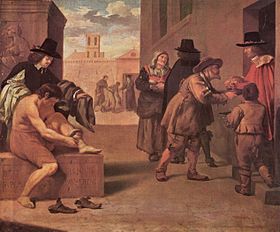- Works of Mercy
-
The Works of Mercy or Acts of Mercy are actions and practices which Christianity in general, and the Methodist Church, Roman Catholic Church and the Eastern Orthodox Church in particular, consider expectations to be fulfilled by believers, and are a means of grace,[1] which aid in sanctification.[2]
The Works of Mercy have been traditionally divided into two categories, with seven elements each: the Corporal Works of Mercy, which concern the material needs of others, and the Spiritual Works of Mercy.[3][4][5]
These concepts (e.g. feeding the hungry, sheltering the homeless) have existed in many Christian Churches including Roman Catholicism, Orthodox Christianity, Lutheranism, and the Anglican Communion.
Beginning in the 20th century, the Roman Catholic tradition saw an extension of the framework for the traditional Works of Mercy with the establishment of the devotion to Divine Mercy and encyclicals such as Dives in Misericordia.[5][6]
Contents
Biblical basis
These works, it is believed, express mercy, and are thus expected to be performed by believers insofar as they are able, in accordance with the Beatitude, "Blessed are the merciful, for they shall obtain mercy" (Gospel of Matthew 5:7).
These acts are to keep the two greatest commandments (Matthew 22:35-40):
Then one of them, a lawyer, asked Him a question, testing Him, and saying, "Teacher, which is the greatest commandment in the law?" Jesus said to him: "'You shall love the Lord your God with all your heart, with all your soul, and with all your mind'. This is the first and great commandment. And the second is like it: 'You shall love your neighbor as yourself.' On these two commandments hang all the Law and the Prophets."
Catholicism
Corporal works of mercy
Corporal Works of Mercy are those that tend to bodily needs. In (Matthew 25:31-46, in the The Judgment of Nations six specific Works of Mercy are enumerated, although not this precise list — as the reason for the salvation of the saved, and the omission of them as the reason for damnation. The last work of mercy, burying the dead, comes from the Book of Tobit.[3][4]
- To feed the hungry
- To give drink to the thirsty.
- To shelter the homeless.
- To clothe the naked.
- To visit and ransom the captive, (prisoners).
- To visit the sick.
- To bury the dead.
 Works of Mercy, by the Master of Alkmaar in 1504, for the St. Lawrence church in Alkmaar. The panels show the works of mercy in this order: feed the hungry, give drink to the thirsty, clothe the naked, bury the dead, shelter the traveler, comfort the sick, and free the imprisoned.
Works of Mercy, by the Master of Alkmaar in 1504, for the St. Lawrence church in Alkmaar. The panels show the works of mercy in this order: feed the hungry, give drink to the thirsty, clothe the naked, bury the dead, shelter the traveler, comfort the sick, and free the imprisoned.
Spiritual works of mercy
Not everyone is considered capable or obligated to perform the first three spiritual works of mercy if they do not have proper tact, knowledge or training to do so. The last four are considered to be the obligation of all people without condition.[4]
- Instruct the uninformed
- Counsel the doubtful;
- Admonish sinners;
- Bear wrongs patiently;
- Forgive offenses willingly;
- Comfort the afflicted;
- Pray for the living, the sick and the dead.
Divine Mercy
Main article: Divine MercyIn the 20th century, there was new focus on mercy in the Roman Catholic Church, partly due to the Divine Mercy devotion , due to Saint Mary Faustina Kowalska (1905–1938), who is known as the Apostle of Mercy, which is followed by over 100 million Catholics.[9][10][11]
In the Divine Mercy devotion one lets the love and mercy of God flow through one's own heart towards those in need of it.[10]
In Diary: Divine Mercy in My Soul (Notebook II, item 742) Faustina wrote that Jesus told her:
"I demand from you deeds of mercy, which are to arise out of love for Me." and that he explained that there are three ways of exercising mercy toward your neighbor: the first-by deed, the second-by word, the third-by prayer.[5]
Pope John Paul II was a follower of the Divine Mercy devotion, and canonized Faustina.[11][12] In his encyclical Dives in Misericordia he examined not only God's mercy, but also the need for human mercy.[6]
Methodism
Works of mercy, are a prudential means of grace.[13] Along with Works of Piety, they are necessary for the believer to move onto Christian perfection.[14] In this sense, the Methodist concern for people at the margins is closely related to its worship.[15] As such, these beliefs have helped create the emphasis of the social gospel in the Methodist Church.[16]
- Doing Good
- Visiting the Sick and Prisoners
- Feeding and Clothing People
- Earning, Saving, Giving All One Can
- Opposition to Slavery
Nature of the obligation
The actual obligation in a given case depends largely on the degree of distress to be aided, and the capacity or condition of the one whose duty in the matter is in question. There are easily recognizable limits as the performance of the corporal works of mercy is concerned.
Likewise the law imposing spiritual works of mercy is subject in individual instances to important reservations.
See also
- Works of Piety
- Fathers of Mercy
- Mercy Corps
- Our Lady of Mercy
- Sisters of Mercy
References
- ^ John Stephen Bowden. Encyclopedia of Christianity. Oxford University Press. http://books.google.com/books?id=NGAUAQAAIAAJ&q=works+of+mercy+methodism&dq=works+of+mercy+methodism&hl=en&ei=FT0TTrqAO4jl0QHH_dS-Dg&sa=X&oi=book_result&ct=result&resnum=6&ved=0CEMQ6AEwBQ. Retrieved 5 July 2011. "Works of mercy are, therefore, not merely good deeds but also channels through which Christians receive God's grace."
- ^ John Wesley. The Works of the Reverend John Wesley, A.M., Volume VI. J. Emory & B. Waugh; J. Collord, New York. p. 46. http://books.google.com/books?id=q4BPAAAAYAAJ&pg=PA46&dq=works+of+mercy+sanctification&hl=en&ei=Xj8TTt6pHMnd0QHt84C5Dg&sa=X&oi=book_result&ct=result&resnum=10&ved=0CFkQ6AEwCQ#v=onepage&q=works%20of%20mercy%20sanctification&f=false. Retrieved 5 July 2011. "Why, that both repentance, rightly understood, and the practice of all good works, — works of piety, as well as works of mercy, (now properly so called, since they spring from faith,) are, in some sense, necessary to sanctification."
- ^ a b The works of mercy by James F. Keenan 2004 ISBN 0742532208 pages 9-12
- ^ a b c Catholic encyclopedia: Corporal and Spiritual Works of Mercy
- ^ a b c Mercies Remembered by Matthew R Mauriello 2011 ISBN 1612150055 page 149-160
- ^ a b Vatican website: Dives in Misericordia
- ^ Tim Drake, 2002, Saints of the Jubilee, ISBN 9781403310095 pages 89-90
- ^ Faustina: The Apostle of Divine Mercy by Catherine M. Odell 1998 ISBN 0879739231 page 66
- ^ Am With You Always by Benedict Groeschel 2010 ISBN 9781586172572 page 548
- ^ a b Ann Ball, 2003 Encyclopedia of Catholic Devotions and Practices ISBN 0-87973-910-X page 175
- ^ a b Butler's lives of the saints: the third millennium by Paul Burns, Alban Butler 2001 ISBN 9780860123835 page 252
- ^ Saints of the Jubilee by Tim Drake 2002 ISBN 9781403310095 pages 85-95
- ^ "Mission: The Works of Mercy". The United Methodist Church. http://gbgm-umc.org/umw/wesley/mission.stm. Retrieved 5 July 2011. "John Wesley believed that "means of grace," include both "works of piety" (instituted means of grace) and "works of mercy" (prudential means of grace). He preached that Christians must do both works of piety and works of mercy in order to move on toward Christian perfection."
- ^ "Mission: The Works of Mercy". The United Methodist Church. http://gbgm-umc.org/umw/wesley/action.stm. Retrieved 5 July 2011. "Christian Perfection is "holiness of heart and life." It is "walking the talk." John Wesley expected Methodists to do not only "works of piety" but "works of mercy"--both of these fused together put a Christian on the path to perfection in love."
- ^ John Stephen Bowden. Encyclopedia of Christianity. Oxford University Press. http://books.google.com/books?id=NGAUAQAAIAAJ&q=works+of+mercy+methodism&dq=works+of+mercy+methodism&hl=en&ei=FT0TTrqAO4jl0QHH_dS-Dg&sa=X&oi=book_result&ct=result&resnum=6&ved=0CEMQ6AEwBQ. Retrieved 5 July 2011. "In this sense, Methodist concern for people at the margins is closely related to its worship."
- ^ Edward Craig. Routledge Encyclopedia of Philosophy: Questions to sociobiology. Taylor & Francis. http://books.google.com/books?id=NfRXYYhpLekC&pg=PA457&dq=methodism+sanctification+works+of+mercy&hl=en&ei=6VgTTuXIBeXc0QGU6pGnAg&sa=X&oi=book_result&ct=result&resnum=10&ved=0CFcQ6AEwCTge#v=onepage&q&f=false. Retrieved 5 July 2011. "He clearly thought that there is an experience of sanctification in which there is a total death to sin and a complete renewal of the image of God. His various qualifications concerning the nature of perfection did not, however, weaken the Methodist stress that one must press on towards perfection in theis life. Much of the social activism of Methodism sprang from this stress."
External links
- "Corporal and Spiritual Works of Mercy" at the Catholic Encyclopedia
- "The Means of Grace" by the Rt. Rev. John Wesley
Methodism Background 
Distinctive doctrines Articles of Religion · Four Sources of Theological Authority · Prevenient Grace · New Birth · Governmental Atonement · Imparted righteousness · Christian perfection · Conditional preservation of the saints · Works of Piety · Works of Mercy · AssurancePeople Richard Allen · Francis Asbury · Thomas Coke · William Law · William Williams Pantycelyn · Howell Harris · Albert C. Outler · James Varick · Charles Wesley · John Wesley · George Whitefield · Countess of Huntingdon · Bishops · TheologiansLargest groups Related and
uniting movements This article incorporates text from a publication now in the public domain: Herbermann, Charles, ed (1913). Catholic Encyclopedia. Robert Appleton Company.Categories:
This article incorporates text from a publication now in the public domain: Herbermann, Charles, ed (1913). Catholic Encyclopedia. Robert Appleton Company.Categories:- Methodism
- Religious ethics
- Catholic theology and doctrine
- Christian terms
Wikimedia Foundation. 2010.


